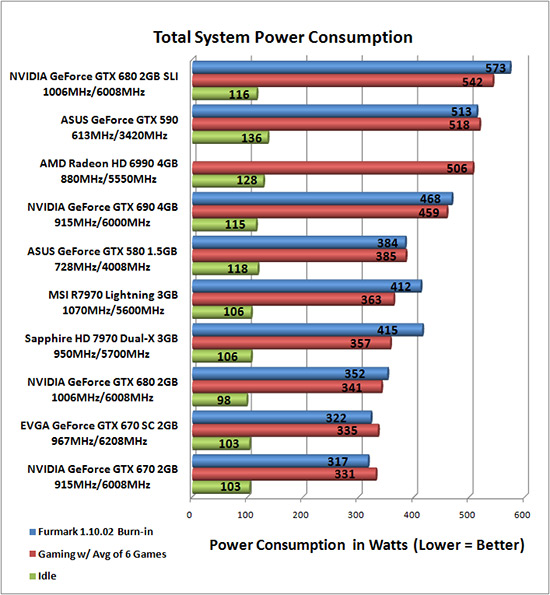NVIDIA & EVGA GeForce GTX 670 2GB Video Card Review
Power Consumption
For testing power consumption, we took our test system and plugged it
into a Kill-A-Watt power meter. For idle numbers, we allowed the system
to idle on the desktop for 15 minutes and took the reading. For load
numbers we measured the peak wattage used by the system while running
the OpenGL benchmark FurMark 1.10.0 at 800×600 resolution. We also ran six game titles at 1920×1080 and averaged the peak results recorded the highest Wattage seen on the meter for the gaming results.

The Performance per watt on the NVIDIA GeForce GTX 6670 is up to 2.5 times greater than GeForce GTX 470! It is supposed to be very power efficient, so this will be interested to check out. The AMD Radeon HD 6990 with Catalyst 12.4 WHQL drivers doesn’t play nice with Furmark in full-screen mode, so we will not be including those results.

Power Consumption Results: Both of the GeForce GTX 670’s had lower power consumption under load than any of our previous video cards. It isn’t surprising that the EVGA GeForce GTX 670 SC draws slightly more power under load than the reference card. When running furmark, the EVGA GeForce GTX 670 SC pulled 322 Watts while the reference GTX 670 pulled 317 Watts. When taking the average of our 6 games, the EVGA GeForce GTX 670 SC had an average power consumption of 335 Watts and the reference GTX 670 averaged 331 Watts. We were expecting the Idle power consumption to be lower than the power consumption of the GTX 680 since the 670’s each have one of the Streaming Multiprocessor (SMX) units disabled. Though being disabled doesn’t mean that it isn’t getting power. There are rumors floating around that the GeForce GTX 680’s that were sent out to the review sites were cherry picked to run cooler, and boost further than the retail cards. There isn’t any proof of this, but the rumors are flying. This would explain why the idle power consumption of the NVIDIA GTX 680 is lower than the GTX 670’s by ~5%.

Comments are closed.